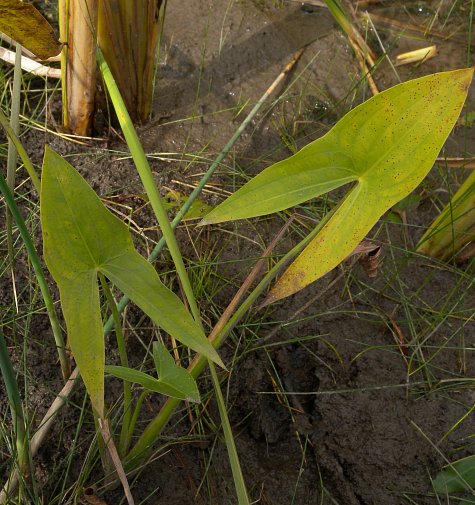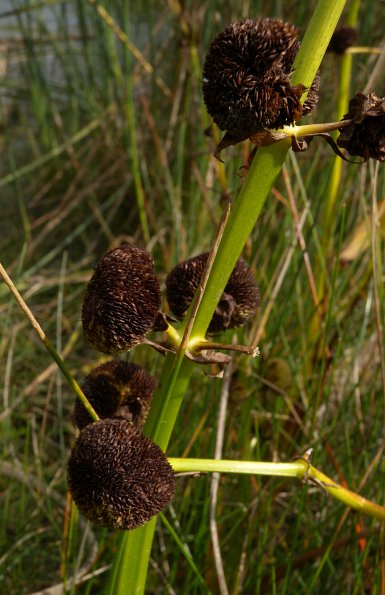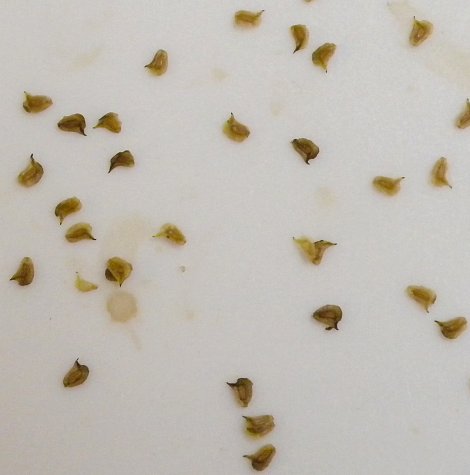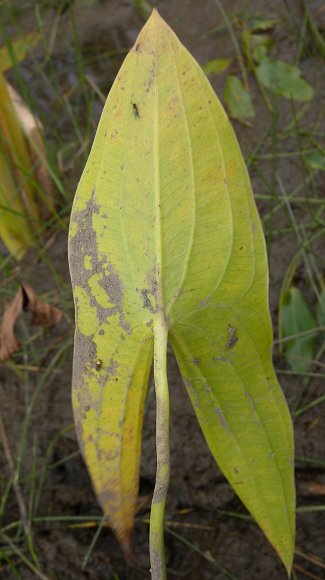Description: This perennial plant is an emergent-aquatic and 1-3' tall, consisting of a rosette of basal leaves and one or more flowering stalks. Mature leaves are 4-14" long and 3-10" across; they are sagittate or hastate in shape and smooth along their margins. The leaves have conspicuous primary veins and smaller lateral veins; their venation is palmate-parallel overall. There is considerable variability in the width of the leaves and the length of their basal lobes across different populations. However, the basal lobes are at least as long as the main bodies (or terminal lobes) of the leaves. The upper leaf surface is pale green, medium green, or yellowish green, while the lower leaf surface is pale green or yellowish green. Both sides of the leaves are glabrous. The ascending petioles of the leaves are 6-18" long and rather stout; they broaden toward the base and become sheath-like. Each petiole is flat on one side, otherwise it is rounded (convex). The flowering stalks (including both peduncles & floral rachises) are about as tall as the leaves or slightly taller and ascending to erect; they are angular or terete. These stalks are either branched or unbranched; sometimes 1-2 lateral branches are produced below the rachis of the terminal stalk. Each branch of the inflorescence terminates in a raceme of whorled flowers; there are 2-3 flowers per whorl. The terminal raceme typically has 3-9 whorls of flowers, while the lateral racemes (if present) have 2-5 whorls of flowers. The whorls of flowers are spaced about 1-2" apart along each raceme.
Most plants are monoecious; the male (staminate) flowers are located above the female (pistillate) flowers in each raceme. Occasionally, dioecious plants occur, and sometimes perfect flowers are produced. Underneath each whorl of flowers, there are 2-3 floral bracts that join together at the base. These floral bracts are up to ½" long, linear-lanceolate to lanceolate in shape, green, and glabrous. Each flower is about 1" across, consisting of 3 white rounded petals and 3 green ovate sepals. The male flowers have numerous stamens that are yellow, while the female flowers have clustered carpels that are green and form a small bur-like mass. The filaments of the stamens are hairless. The spreading to ascending pedicels of the flowers are up to 1" long; they are green and glabrous. The blooming period occurs from mid-summer to early fall, lasting about 1-3 months for a colony of plants. Afterwards, the female flowers are replaced by bur-like fruits that are up to ¾" across at maturity, changing in color from green to dark brown as they mature. These fruits are are globoid to subgloboid (globoid, but slightly flattened) in shape, consisting of a dense cluster of achenes. Because of the lateral beaks of the achenes, these bur-like fruits appear more streaked than prickly. The sepals of these fruits are widely spreading to recurved; they slowly wither away. Individual achenes are 2.0-3.0 mm. long, 1.5-2.0 across, and flattened-obovoid or flattened-obdeltoid in shape; some of their margins are membranous and winged. Each achene has a more or less straight beak about 1.0-1.5 mm. in length that projects laterally from its upper side.
The root system consists of a tuft of coarse fibrous roots and long spreading stolons, from which starchy tubers are occasionally produced. This plant reproduces by reseeding itself or by forming clonal plants from the tuberous stolons. Colonies of plants sometimes develop at favorable sites.
Cultivation: The preference is full or partial sun, shallow water up to 1' deep or wet conditions, and fertile soil containing some organic matter. This emergent-aquatic plant usually grows in shallow water that is stagnant or slow-moving.
Range & Habitat: The native Common Arrowhead (Sagittaria latifolia) is common in central and northern Illinois, while in the southern section of the state it is occasional or absent (see Distribution Map). Habitats include large swales in open woodlands, swamps, marshes, bogs, seeps, low-gradient edges of ponds and reservoirs, low-gradient edges of slow-moving streams and drainage canals, and deep ditches. This species is reportedly tolerant of polluted water; it can be found in both disturbed and higher quality wetlands.
Faunal Associations: The nectar and pollen of the flowers attract a variety of insects, including honeybees, bumblebees, little carpenter bees (Ceratina spp.), Halictid bees, wasps, Syrphid flies, Tachinid flies, butterflies, skippers, and beetles. These insects cross-pollinate the flowers. Other insects feed destructively on the leaves, stalks, roots, and other parts of Common Arrowhead and other Arrowhead species (Sagittaria spp.). These insects include leaf beetles (primarily Donacia spp.), weevils (primarily Listronotus spp.), the Waterlily Aphid (Rhopalosiphum nymphaeae), larvae of the Obscure Pondweed Moth (Parapoynx obscuralis), wetland-loving grasshoppers (especially Paroxya spp.), the Short-winged Meadow Katydid (Conocephalus brevipennis), and the larvae of several caddisflies (especially Triaenodes spp.). See the Insect Table for a more complete listing of these species. Some vertebrate animals also feed on these wetland plants, especially ducks, which feed on their seeds and/or tubers (see the Bird Table for a listing of these species). In addition, muskrats feed on the stalk bases, crowns, and tubers (Martin et al., 1951/1961; Hamerstrom & Blake, 1939), and such turtles as Chelydra serpentina (Snapping Turtle), Chrysemys picta (Painted Turtle), Pseudemys concinna (River Cooter), and Trachemys scripta (Slider) reportedly feed on these Arrowhead species (Ernst et al., 1994).
Photographic Location: Along a drainage canal at the Windsor Road Prairie in Champaign, Illinois.
Comments: Both the foliage and flowers of Common Arrowhead (Sagittaria latifolia) are fairly attractive. The tubers and seeds of this species are an important source of food to ducks. Across different populations of plants, Common Arrowhead has basal leaves that vary considerably in their width and the length of their basal lobes, although they retain a sagittate or hastate shape. The size of the basal leaves and the length of the flowering stalks can also vary significantly. Common Arrowhead can be distinguished from similar Arrowhead species (Sagittaria spp.) by the beaks of its achenes. These beaks extend laterally from the upper sides of its achenes; they are relatively straight, and about 1.0-1.5 mm. in length. Other Arrowhead species have more erect beaks on the upper sides of their achenes; for some species, these beaks are curved rather than straight, and they may be shorter (0.5 mm. or less) or they may be longer (2-3 mm.) than the beaks on the achenes of Common Arrowhead. Another useful distinction is the length of the basal lobes on the leaves of Common Arrowhead: they are as long as, or longer than, the main body (or terminal lobe) of each leaf. Other Arrowhead species often have basal lobes that are shorter than the main bodies (or terminal lobes) of their leaves, or they may have leaves that lack basal lobes altogether. Some Arrowhead species also differ by having sessile flowers (or fruits) on their flowering stalks, or the pedicels of their flowers (or fruits) are more stout and drooping, rather than ascending to widely spreading.



